Related Research Articles
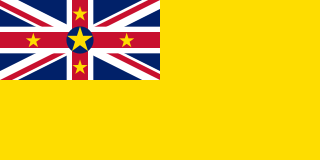
Niue is an island country in the South Pacific Ocean, 2,400 kilometres (1,500 mi) northeast of New Zealand. Niue's land area is about 261 square kilometres (101 sq mi) and its population, predominantly Polynesian, was about 1,600 in 2016. Niue is located in a triangle between Tonga, Samoa, and the Cook Islands. It is 604 kilometers northeast of Tonga. The island is commonly referred to as "The Rock", which comes from the traditional name "Rock of Polynesia". Niue is one of the world's largest coral islands. The terrain of the island has two noticeable levels. The higher level is made up of a limestone cliff running along the coast, with a plateau in the centre of the island reaching approximately 60 metres above sea level. The lower level is a coastal terrace approximately 0.5 km wide and about 25–27 metres high, which slopes down and meets the sea in small cliffs. A coral reef surrounds the island, with the only major break in the reef being in the central western coast, close to the capital, Alofi.

Oceania is a geographic region that includes Australasia, Melanesia, Micronesia and Polynesia. Spanning the Eastern and Western Hemispheres, Oceania has a land area of 8,525,989 square kilometres (3,291,903 sq mi) and a population of over 41 million. When compared to continents, the region of Oceania is the smallest in land area and the second smallest in population after Antarctica.

Tokelau is a dependent territory of New Zealand in the southern Pacific Ocean. It consists of three tropical coral atolls:. They have a combined land area of 10 km2 (4 sq mi). The capital rotates yearly among the three atolls. In addition to these three, Swains Island, which forms part of the same archipelago, is the subject of an ongoing territorial dispute; it is currently administered by the United States as part of American Samoa. Tokelau lies north of the Samoan Islands, east of Tuvalu, south of the Phoenix Islands, southwest of the more distant Line Islands, and northwest of the Cook Islands.

Tuatara are reptiles endemic to New Zealand, belonging to the genus Sphenodon. Although resembling most lizards, they are part of a distinct lineage, the order Rhynchocephalia. Their name derives from the Māori language, and means "peaks on the back". The single species of tuatara is the sole surviving member of its order, which originated in the Triassic period around 250 million years ago and which flourished during the Mesozoic era. Their most recent common ancestor with any other extant group is with the squamates. For this reason, tuatara are of interest in the study of the evolution of lizards and snakes, and for the reconstruction of the appearance and habits of the earliest diapsids, a group of amniote tetrapods that also includes dinosaurs and crocodilians.
Aotearoa is the Māori name for New Zealand. It was originally used by the Māori people in reference to only the North Island but, since the late 19th century, the word has come to refer to the country as a whole. Several meanings have been proposed for the name; the most popular translation usually given is "long white cloud", or variations thereof. This refers to the cloud formations which helped early Polynesian navigators find the country.

The Tasman Sea is a marginal sea of the South Pacific Ocean, situated between Australia and New Zealand. It measures about 2,000 km (1,200 mi) across and about 2,800 km (1,700 mi) from north to south. The sea was named after the Dutch explorer Abel Janszoon Tasman, who was the first recorded European to encounter New Zealand and Tasmania. British explorer Lieutenant James Cook later extensively navigated the Tasman Sea in the 1770s as part of his first voyage of exploration.

Cook Strait separates the North and South Islands of New Zealand. The strait connects the Tasman Sea on the northwest with the South Pacific Ocean on the southeast, and runs next to the capital city, Wellington. It is 22 kilometres (14 mi) wide at its narrowest point, and is considered one of the most dangerous and unpredictable waters in the world. Regular ferry services run between Picton in the Marlborough Sounds and Wellington.
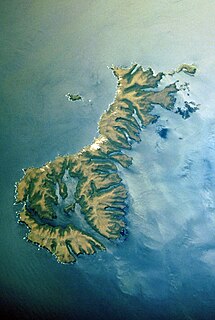
The Auckland Islands are an archipelago of New Zealand, lying 465 kilometres (290 mi) south of the South Island. The main Auckland Island, occupying 510 km2 (200 sq mi), is surrounded by smaller Adams Island, Enderby Island, Disappointment Island, Ewing Island, Rose Island, Dundas Island, and Green Island, with a combined area of 626 km2 (240 sq mi). The islands have no permanent human inhabitants.
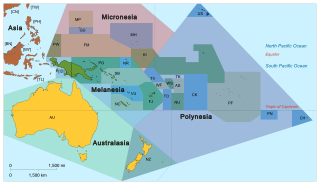
Pacific Islanders, Pasifika, or Pasefika, are the peoples of the Pacific Islands. It is a geographic and ethnic/racial term to describe the inhabitants and diaspora of any of the three major sub-regions of Oceania. It is also sometimes used to describe inhabitants of the Pacific islands.
Polynesians form an ethnolinguistic group of closely related people who are native to Polynesia, an expansive region of Oceania in the Pacific Ocean. They trace their early prehistoric origins to Island Southeast Asia and form part of the larger Austronesian ethnolinguistic group with an Urheimat in Taiwan. They speak the Polynesian languages, a branch of the Oceanic subfamily of the Austronesian language family.
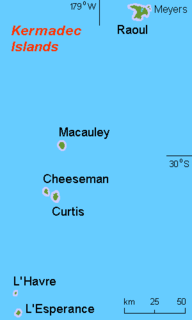
The Kermadec Islands are a subtropical island arc in the South Pacific Ocean 800–1,000 km (500–620 mi) northeast of New Zealand's North Island, and a similar distance southwest of Tonga. The islands are part of New Zealand, 33.6 km2 (13.0 sq mi) in total area and uninhabited, except for the permanently manned Raoul Island Station, the northernmost outpost of New Zealand.

HMNZS Leander was a light cruiser which served with the Royal New Zealand Navy during World War II. She was the lead ship of a class of eight ships, the Leander-class light cruiser and was initially named HMS Leander.

The New Zealand Army is the land component of the New Zealand Defence Force and comprises around 4,500 Regular Force personnel, 2,000 Territorial Force personnel and 500 civilians. Formerly the New Zealand Military Forces, the current name was adopted by the New Zealand Army Act 1950. The New Zealand Army traces its history from settler militia raised in 1845.

The New Zealand bellbird, also known by its Māori names korimako and makomako, is a passerine bird endemic to New Zealand. It has greenish colouration and is the only living member of the genus Anthornis. The bellbird forms a significant component of the famed New Zealand dawn chorus of bird song that was much noted by early European settlers. The explorer Captain Cook wrote of its song "it seemed to be like small bells most exquisitely tuned". Its bell-like song is sometimes confused with that of the tui. The species is common across much of New Zealand and its offshore islands as well as the Auckland Islands.
The 164th Infantry Division was an infantry division of the German Army during World War II. Formed in November 1939, the division took part in the invasion of Greece in April 1941. In January 1942, consolidating the Axis seizure of the island during the Battle of Crete, the 164th was reorganized as Fortress Division Kreta (FDK). In mid-1942 the division was transferred to North Africa and re-designated as 164th Light Afrika Division. It surrendered in May 1943 in Tunisia at the end of the North African Campaign.

The Realm of New Zealand consists of the entire area in which the monarch of New Zealand functions as head of state. The Realm of New Zealand is not a federation; it is a collection of states and territories united under its monarch. New Zealand is an independent and sovereign state. It has one Antarctic territorial claim, one dependent territory (Tokelau), and two associated states.
Montgomery Junior "Monty" Betham is a professional boxer, and former professional rugby league footballer. A New Zealand international representative hooker and lock, he played club football for the New Zealand Warriors in the National Rugby League, and for the Wakefield Trinity Wildcats (captain) in the Super League.

New Zealand is an island country in the southwestern Pacific Ocean. It consists of two main landmasses—the North Island and the South Island —and more than 700 smaller islands, covering a total area of 268,021 square kilometres (103,500 sq mi). New Zealand is about 2,000 kilometres (1,200 mi) east of Australia across the Tasman Sea and 1,000 kilometres (600 mi) south of the islands of New Caledonia, Fiji, and Tonga. The country's varied topography and sharp mountain peaks, including the Southern Alps, owe much to tectonic uplift and volcanic eruptions. New Zealand's capital city is Wellington, and its most populous city is Auckland.
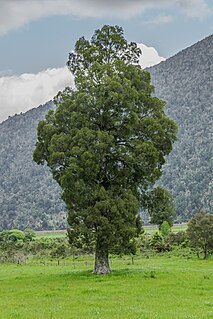
Libocedrus bidwillii, also called pāhautea, kaikawaka or New Zealand cedar, is a species of Libocedrus, endemic to New Zealand. It is in the cypress family Cupressaceae.

East Cape Lighthouse is a lighthouse sited on Otiki Hill above East Cape, the easternmost point on the North Island of New Zealand. It is owned and operated by Maritime New Zealand. The lighthouse was originally constructed on nearby East Island. However the island was difficult to access and proved to be susceptible to earthquakes and subsequent landslips. In 1920 a decision was made to relocate the light to the mainland and in April 1922, the light was extinguished and then relit at its current location in December of that year. Originally manned by three lighthouse keepers, the light's staffing was progressively reduced until it was fully automated in 1985. It is now controlled from the Maritime New Zealand headquarters in Wellington. While the area around the light is accessible by foot, the lighthouse itself is not open to the public.
References
- ↑ Cook, Steve De C., New Zealand Coastal Marine Invertebrates Vol 1, Canterbury University Press, NZ 2010 ISBN 978-1877257-60-5
- Powell A. W. B., New Zealand Mollusca, William Collins Publishers Ltd, Auckland, New Zealand 1979 ISBN 0-00-216906-1